Coat of arms of Serbia facts for kids
Quick facts for kids Coat of arms of Serbia |
|
|---|---|
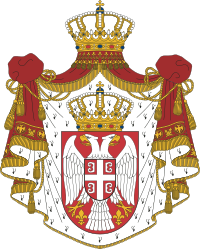 |
|
| Versions | |

Lesser coat of arms
|
|
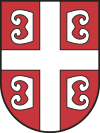
Shield
|
|
| Armiger | Republic of Serbia |
| Adopted | 1882 (Coat of arms of Kingdom of Serbia) 2004 (readoption) 2010 (standardized) |
| Blazon | Gules, between two fleurs-de-lys in base Or, a double-headed eagle displayed inverted Argent, armed, beaked and langued Or, surmounted by an escutcheon Gules thereon a cross between four firesteels Argent |
| Other elements | The shield is ensigned with a crown Or. The whole is within a mantle Gules fringed and tasselled Or, lined ermine and crowned Or |
| Earlier version(s) | See history and gallery |
| Use | Governmental |
The coat of arms of the Republic of Serbia is an important national symbol. It was first used in 1882 when Serbia was a kingdom. Later, it was officially brought back in 2004 and updated a bit in 2010.
This coat of arms shows two main symbols. These symbols have been important to the Serbian people for hundreds of years. They are the Serbian eagle (a silver double-headed eagle) and the Serbian cross (a cross with four shapes that look like firesteels).
Contents
What the Coat of Arms Looks Like
Serbia has two main versions of its coat of arms: the "greater" and "lesser" coats of arms.
The greater coat of arms shows a red shield. On this shield, there is a silver double-headed eagle. The eagle has golden beaks, tongues, and legs. Below the eagle, there are two golden fleur-de-lis symbols. On the eagle's chest, there is a smaller red shield. This small shield has a silver cross with four silver "firesteels" around it. The whole shield is topped with a golden crown. It is also surrounded by a red cloak, called a mantle. This mantle is decorated with gold and lined with ermine fur, and it also has a golden crown on top.
The lesser coat of arms is simpler. It's the same red shield with the silver double-headed eagle, the golden fleurs-de-lys, and the small red shield on the eagle's chest with the cross and firesteels. But it only has the golden crown on top of the main shield, without the large mantle.
The main red shield with the white double-headed eagle stands for the Serbian state. The small shield on the eagle's chest, with the cross and firesteels, represents the Serbian nation.
Even though Serbia is now a republic (meaning it has a president, not a king or queen), its coat of arms still uses symbols from its royal past. The golden crown and the ermine mantle are examples of these royal symbols. The lesser coat of arms is used more often today. You can see it on passports, identity cards, and the state flag.
The Eagle Symbol
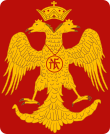
The double-headed eagle symbol has a long history. It was first used in the Byzantine Empire over 900 years ago. You can find this symbol on old buildings, paintings, and royal clothes from that time.
In Serbia, one of the first rulers to use this symbol was Grand Prince Stefan Nemanja (who ruled from 1166 to 1196). The Serbian Orthodox Church also adopted it. For example, the entrance of the Žiča monastery, an important church for Serbian kings, has the double-headed eagle carved into it. The Nemanjić dynasty, a powerful Serbian royal family, used the double-headed eagle as their main symbol.
During the rule of Emperor Stefan Dušan (1331–1345), the double-headed eagle was used on many everyday items and official documents. It even appeared on a map in 1339, showing the Serbian Empire with a flag that had a red double-headed eagle. Other Serbian royal families, like the Mrnjavčević and Lazarević, also used this symbol to show they were continuing the traditions of earlier Serbian rulers.
The Cross Symbol
The Serbian Cross, with its four shapes around it, might also come from the Byzantine Empire. It looks very similar to a symbol used on Byzantine flags a long time ago.
Some historians believe it became an official Serbian symbol around 1345. Others think it started being used as a national symbol later, around 1397, during the rule of Stefan Lazarević.
Later, the Serbian cross appeared in old books about coats of arms. It was shown as a white cross on a red and gold background. It was used by important Serbian rulers like Vukašin Mrnjavčević and Lazar Hrebeljanović.
In 1825, Miloš Obrenović made the Serbian cross the military flag when he created the first regular army units. Since then, the Serbian cross has been on almost all Serbian coats of arms. However, the Serbian coat of arms from 1947 had the cross removed, leaving only the four stylized shapes. This was done by the government at the time to reduce the role of religion in public life.
Today, some people in Serbia believe the four shapes around the cross look like the Cyrillic letter "C". This idea is sometimes seen on older coats of arms. However, in most of these coats of arms, the shapes still look like the letter "B" or have a straight side, not a perfect "C".
The Palaiologan cross, which is similar to the Serbian cross, first appeared as a Serbian coat of arms in a book in 1701. After this book, the Serbian church started using the symbol. It became very popular, and Milos Obrenovic made it official in 1838.
History of the Serbian Coat of Arms
| Period | Dates used | Coat of arms | Description | |
|---|---|---|---|---|
| Medieval Serbian Kingdom | 1217–1346 | 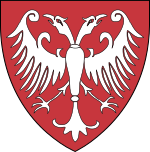 |
This coat of arms features the Serbian eagle. It was the symbol of the Nemanjić dynasty. | |
| Serbian Empire | 1346–1371 |  |
This also shows the coat of arms of the Nemanjić dynasty. | |
| Moravian Serbia | 1371–1402 |  |
This was the coat of arms of the Lazarević dynasty. | |
| Serbian Despotate | 1402–1459 | The coat of arms shows a golden double-headed eagle on a red background. It has a special cap on the shield. This eagle was a traditional symbol of the Nemanjić dynasty. | ||
| Habsburg-occupied Serbia | 1686–1699 | 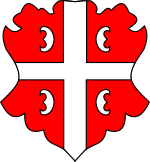 |
This coat of arms features the Serbian cross. | |
| Habsburg Kingdom of Serbia | 1718–1739 | This coat of arms shows a black boar's head with an arrow in a silver field. This symbol is one of the oldest attributed to Serbia. | ||
| Koča's frontier (Habsburg-occupied Serbia) | 1788–1792 | 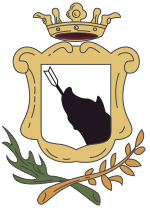 |
||
| Revolutionary Serbia | 1804–1813 | 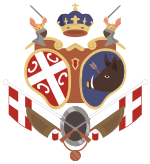 |
This coat of arms combined the Serbian cross and the boar's head. | |
| Principality of Serbia | 1835–1882 | 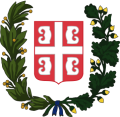 |
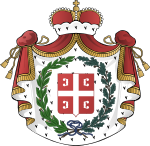 |
This coat of arms shows a white cross on a red field with four points. It has a princely crown and a red princely cloak behind the shield. |
| Kingdom of Serbia | 1882–1918 (Still in use) | 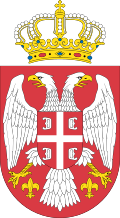 |
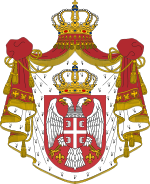 |
This is the Royal Coat of arms of Serbia, which is still in use today. |
| Kingdom of Serbs, Croats and Slovenes / Kingdom of Yugoslavia | 1918–1941 | 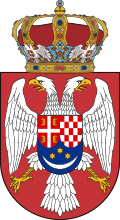 |
 |
This was the coat of arms for the Kingdom of Yugoslavia. It included symbols for Serbs, Croats, and Slovenes. |
| Government of National Salvation (German-occupied Serbia) | 1941–1944 | 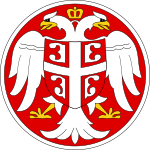 |
||
| Socialist Republic of Serbia and Republic of Serbia | 1947–2004 | 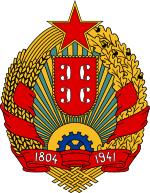 |
This emblem was adopted in 1947. It used the traditional shield with four firesteels, but the cross was removed. It also had a rising sun, a cog wheel (for workers), and a wreath of wheat and oak leaves. A red ribbon showed dates for important Serbian uprisings. | |
| Federal Republic of Yugoslavia / State Union of Serbia and Montenegro | 1993–2006 |  |
This was the coat of arms for Serbia and Montenegro, showing symbols for both regions. | |
| Republic of Serbia | 2004–2010 |  |
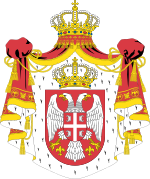 |
This is a modern version of the coat of arms for the Republic of Serbia. |
See also
 In Spanish: Escudo de Serbia para niños
In Spanish: Escudo de Serbia para niños
- Serbian eagle
- Double-headed eagle
- Serbian cross
- Armorial of Serbia
- Serbian heraldry
- Coat of arms of Triballia


